Radio Frequency Identification and Sensing Techniques and Their Applications—A Review of the State-of-the-Art
Abstract
:1. Introduction
2. The Fundamentals of RF Energy Harvesting and RFID Sensor Techniques
2.1. HF Inductive Coupling and HF RFID Sensor Techniques
2.2. UHF Backscattering and UHF Sensor Techniques
2.2.1. Interrogator-to-Tag RF Power Transfer
2.2.2. UHF RFID Power Reflection
2.3. Chip-less RFID Sensors
3. RFID Sensor Techniques—Technical Progresses and Innovative Applications
3.1. Technical Progress of RFID Integrated Sensing
3.1.1. Novel Antenna Designs: The Front End of RFID Sensing Techniques
3.1.2. RF-to-DC Conversion and Power Management
3.1.3. Printable and Flexible RFID Techniques for Sensor Fabrication
3.2. Commercial Solutions
3.2.1. Promising RFID ICs for Sensor Development
3.2.2. Commercial RFID Sensor Applications
3.3. Innovative Applications
4. Technical Challenges
4.1. Efficiency of RF Frontend Energy Harvesting and Power Conversion
4.2. Heterogeneity in the Enabling Techniques
4.3. Reliability
5. Future Prospectives
5.1. Research Focuses
5.1.1. Integration with New Materials and New Processes
5.1.2. Relay Resonator for Extending RFID Reading Distance
5.1.3. RFID Sensor Based Wireless Sensor Network (WSN)
5.1.4. RFID Sensor Based IoT Applications
5.2. Promising IoT Applications
5.2.1. Product Lifecycle Management (PLM) in Manufacturing Industry
5.2.2. Continuous Monitoring of Human Physical Characteristics
5.2.3. RFID Sensors in Smart Logistics
5.2.4. RFID Sensors in Smart Agriculture
6. Summary
Author Contributions
Funding
Acknowledgments
Conflicts of Interest
References
- Al-Fuqaha, A.; Guizani, M.; Mohammadi, M.; Aledhari, M.; Ayyash, M. Internet of things: A survey on enabling technologies, protocols, and applications. IEEE Commun. Surv. Tutor. 2015, 17, 2347–2376. [Google Scholar] [CrossRef]
- Xu, L.D.; He, W.; Li, S. Internet of things in industries: A survey. IEEE Trans. Ind. Inform. 2014, 10, 2233–2243. [Google Scholar] [CrossRef]
- Want, R. An introduction to RFID technology. IEEE Pervas. Comput. 2006, 1, 25–33. [Google Scholar] [CrossRef]
- Welbourne, E.; Battle, L.; Cole, G.; Gould, K.; Rector, K.; Raymer, S.; Balazinska, M.; Borriello, G. Building the internet of things using RFID: the RFID ecosystem experience. IEEE Internet Comput. 2009, 13, 48–55. [Google Scholar] [CrossRef]
- Wang, T.; He, Y.; Shi, T.; Li, B. Transformer incipient hybrid fault diagnosis based on solar-powered RFID sensor and optimized DBN approach. IEEE Access 2019, 7, 74103–74110. [Google Scholar] [CrossRef]
- Kaneko, M.; Hu, W.; Hayashi, K.; Sakai, H. Compressed sensing-based tag identification protocol for a passive RFID system. IEEE Commun. Lett. 2014, 18, 2023–2026. [Google Scholar] [CrossRef]
- Zeng, L.; Grau, D.; Xiao, Y. Assessing the feasibility of passive and BAP RFID communications on construction site scenarios. IEEE Syst. J. 2015, 10, 1505–1515. [Google Scholar] [CrossRef]
- Zhang, J.; Tian, G.Y.; Marindra, A.M.J.; Sunny, A.I.; Zhao, A.B. A review of passive RFID tag antenna-based sensors and systems for structure health monitoring applications. Sensors 2017, 17, 265. [Google Scholar] [CrossRef]
- Oprea, A.; Bârsan, N.; Weimar, U.; Bauersfeld, M.L.; Ebling, D.; Wöllenstein, J. Capacitive humidity sensors on flexible RFID labels. Sensor. Actuat. B-Chem. 2008, 132, 404–410. [Google Scholar] [CrossRef]
- Occhiuzzi, C.; Paggi, C.; Marrocco, G. Passive RFID strain-sensor based on meander-line antennas. IEEE Trans. Antennas Propag. 2011, 59, 4836–4840. [Google Scholar] [CrossRef]
- Rennane, A.; Abdelnour, A.; Kaddour, D.; Touhami, R.; Tedjini, S. Design of passive UHF RFID sensor on flexible foil for sports balls pressure monitoring. IET Microw. Antennas Propag. 2018, 12, 2154–2160. [Google Scholar] [CrossRef]
- Zhang, J.; Tian, G.Y.; Zhao, A.B. Passive RFID sensor systems for crack detection & characterization. NDT&E Int. 2017, 86, 89–99. [Google Scholar]
- Caizzone, S.; DiGiampaolo, E. Passive RFID Deformation Sensor for Concrete Structures. In Proceedings of the 2014 IEEE RFID Technology and Applications Conference (RFID-TA), Tampere, Finland, 8–9 September 2014; pp. 127–130. [Google Scholar]
- Zarifi, M.H.; Deif, S.; Daneshmand, M. Wireless passive RFID sensor for pipeline integrity monitoring. Sens. Actuat. A-Phys. 2017, 261, 24–29. [Google Scholar] [CrossRef]
- Xiao, Z.; Tan, X.; Chen, X.; Chen, S.; Zhang, Z.; Zhang, H.; Wang, J.; Huang, Y.; Zhang, P.; Zheng, L.; et al. An implantable RFID sensor tag toward continuous glucose monitoring. IEEE J. Biomed. Health 2015, 19, 910–919. [Google Scholar] [CrossRef] [PubMed]
- Caldara, M.; Nodari, B.; Re, V.; Bonandrini, B. Miniaturized and low-power blood pressure telemetry system with RFID interface. Procedia Eng. 2014, 87, 344–347. [Google Scholar] [CrossRef]
- Turner, M.; Naber, J. The Development of a RFID Based Mixed Signal ASIC for the Wireless Measurement of Intraocular Pressure. In Proceedings of the 2010 18th Biennial University/Government/Industry Micro/Nano Symposium, West Lafayette, IN, USA, 28 June–1 July 2010; pp. 1–4. [Google Scholar]
- Caccami, M.C.; Mulla, M.Y.S.; Occhiuzzi, C.; Di Natale, C.; Marrocco, G. Design and experimentation of a batteryless on-skin RFID graphene-oxide sensor for the monitoring and discrimination of breath anomalies. IEEE Sens. J. 2018, 18, 8893–8901. [Google Scholar] [CrossRef]
- Lazaro, A.; Boada, M.; Villarino, R.; Girbau, D. Color measurement and analysis of fruit with a battery-less NFC sensor. Sensors 2019, 19, 1741. [Google Scholar] [CrossRef]
- Lumpkins, W. Nikola Tesla’s dream realized: Wireless power energy harvesting. IEEE Consum. Electron. Mag. 2013, 3, 39–42. [Google Scholar] [CrossRef]
- Brown, W.C. The history of power transmission by radio waves. IEEE Trans. Microw. Theory 1984, 32, 1230–1242. [Google Scholar] [CrossRef]
- Hemour, S.; Wu, K. Radio-frequency rectifier for electromagnetic energy harvesting: Development path and future outlook. Proc. IEEE 2014, 102, 1667–1691. [Google Scholar] [CrossRef]
- Zargham, M.; Gulak, P.G. Maximum achievable efficiency in near-field coupled power-transfer systems. IEEE Trans. Biomed. Circuits Syst. 2012, 6, 228–245. [Google Scholar] [CrossRef] [PubMed]
- De Venuto, D.; Rabaey, J. RFID transceiver for wireless powering brain implanted microelectrodes and backscattered neural data collection. Microelectron. J. 2014, 45, 1585–1594. [Google Scholar] [CrossRef]
- Shan, C.Y.; Shan, Y.F.; Yao, L. Radio Frequency Identification (RFID) Principles and Applications; Electronic Industry Press: Beijing, China, 2015; pp. 25–60. [Google Scholar]
- Cao, X.T.; Chung, W.Y. An enhanced multiplication of RF energy harvesting efficiency using relay resonator for food monitoring. Sensors 2019, 19, 1963. [Google Scholar] [CrossRef] [PubMed]
- Kim, S.; Georgiadis, A.; Tentzeris, M. Design of inkjet-printed RFID-based sensor on paper: Single-and dual-tag sensor topologies. Sensors 2018, 18, 1958. [Google Scholar] [CrossRef] [PubMed]
- AN 1629 UHF RFID Label Antenna Design. Available online: https://www.nxp.com/docs/en/application-note/AN162910.pdf (accessed on 15 July 2019).
- Nikitin, P.V.; Rao, K.V.S.; Lazar, S. An Overview of Near Field UHF RFID. In Proceedings of the 2007 IEEE International Conference on RFID, Grapevine, TX, USA, 26–28 March 2007; pp. 167–174. [Google Scholar]
- Herrojo, C.; Muela, F.J.; Mata-Contreras, J.; Paredes, F.; Martín, F. High-density microwave encoders for motion control and near-field chipless-RFID. IEEE Sens. J. 2019, 19, 3673–3682. [Google Scholar] [CrossRef]
- Feng, Y.; Xie, L.; Chen, Q.; Zheng, L.R. Low-cost printed chipless RFID humidity sensor tag for intelligent packaging. IEEE Sens. J. 2014, 15, 3201–3208. [Google Scholar] [CrossRef]
- Athauda, T.; Karmakar, N.C. The realisation of chipless RFID resonator for multiple physical parameter sensing. IEEE Internet Things 2019, 6, 5387–5396. [Google Scholar] [CrossRef]
- Shen, Y.; Law, C.L. A low-cost UWB-RFID system utilizing compact circularly polarized chipless tags. IEEE Antennas Wirel. Propag. Lett. 2012, 11, 1382–1385. [Google Scholar] [CrossRef]
- Kim, S.; Vyas, R.; Bito, J.; Niotaki, K.; Collado, A.; Georgiadis, A.; Tentzeris, M.M. Ambient RF energy-harvesting technologies for self-sustainable standalone wireless sensor platforms. Proc. IEEE 2014, 102, 1649–1666. [Google Scholar] [CrossRef]
- Bi, S.; Ho, C.K.; Zhang, R. Wireless powered communication: Opportunities and challenges. IEEE Commun. Mag. 2015, 53, 117–125. [Google Scholar] [CrossRef]
- Ng, D.W.K.; Lo, E.S.; Schober, R. Wireless information and power transfer: Energy efficiency optimization in OFDMA systems. IEEE Trans. Wirel. Commun. 2013, 12, 6352–6370. [Google Scholar] [CrossRef]
- Gope, P.; Amin, R.; Islam, S.K.H.; Kumar, N.; Bhalla, V.K. Lightweight and privacy-preserving RFID authentication scheme for distributed IoT infrastructure with secure localization services for smart city environment. Future Gener. Comput. Syst. 2018, 83, 629–637. [Google Scholar] [CrossRef]
- Deng, X.Y.; Wang, Y.; He, Y.J. Passive RFID Electronic Label Wireless Theory and Engineering; Tsinghua University Press: Beijing, China, 2016; pp. 31–91. [Google Scholar]
- Chen, S.L. A miniature RFID tag antenna design for metallic objects application. IEEE Antennas Wirel. Propag. Lett. 2009, 8, 1043–1045. [Google Scholar] [CrossRef]
- Xu, L.; Tian, L.; Hu, B. A Novel Broadband UHF RFID Tag Antenna Mountable on Metallic Surface. In Proceedings of the 2007 International Conference on Wireless Communications, Networking and Mobile Computing, Shanghai, China, 21–25 September 2007; pp. 2128–2131. [Google Scholar]
- Hamani, A.; Yagoub, M.C.E.; Vuong, T.P.; Touhami, R. A novel broadband antenna design for UHF RFID tags on metallic surface environments. IEEE Antennas Wirel. Propag. Lett. 2016, 16, 91–94. [Google Scholar] [CrossRef]
- Li, H.; Zhu, J.; Yu, Y. Compact single-layer RFID tag antenna tolerant to background materials. IEEE Access 2017, 5, 21070–21079. [Google Scholar] [CrossRef]
- Kruesi, C.M.; Vyas, R.J.; Tentzeris, M.M. Design and development of a novel 3-D cubic antenna for wireless sensor networks (WSNs) and RFID applications. IEEE Trans. Antennas Propag. 2009, 57, 3293–3299. [Google Scholar] [CrossRef]
- Jin, X.; Dang, X.; Yang, F. Compact 3-D cubic loop antennas with omnidirectional patterns. In Proceedings of the 2014 IEEE Antennas and Propagation Society International Symposium (APSURSI), Memphis, TN, USA, 6–11 July 2014; pp. 380–381. [Google Scholar]
- Galehdar, A.; Thiel, D.V.; O’Keefe, S.G. Design methods for 3D RFID antennas located on a conducting ground plane. IEEE Trans. Antennas Propag. 2009, 57, 339–346. [Google Scholar] [CrossRef]
- Ma, Z.L.; Jiang, L.J.; Xi, J.; Ye, T.T. A single-layer compact HF-UHF dual-band RFID tag antenna. IEEE Antennas Wirel. Propag. Lett. 2012, 11, 1257–1260. [Google Scholar]
- Keyrouz, S.; Visser, H.J.; Tijhuis, A.G. Multi-Band Simultaneous Radio Frequency Energy Harvesting. In Proceedings of the 2013 7th European Conference on Antennas and Propagation (EuCAP), Gothenburg, Sweden, 8–12 April 2013; pp. 3058–3061. [Google Scholar]
- Li, H.H.; Mou, X.Q.; Ji, Z.; Yu, H.; Li, Y.; Jiang, L. Miniature RFID tri-band CPW-fed antenna optimised using ISPO algorithm. Electron. Lett. 2011, 47, 161–162. [Google Scholar] [CrossRef]
- Tang, Z.J.; He, Y.G.; Wang, Y. Broadband UHF RFID tag antenna with quasi-isotropic radiation performance. AEU-Int. J. Electron. C. 2011, 65, 859–863. [Google Scholar] [CrossRef]
- Liu, Q.; Yu, Y.; He, S. Capacitively loaded, inductively coupled fed loop antenna with an omnidirectional radiation pattern for UHF RFID tags. IEEE Antennas Wirel. Propag. Lett. 2013, 12, 1161–1164. [Google Scholar] [CrossRef]
- Zeng, Y.; Chen, Z.N.; Qing, X.; Jin, J.M. A directional, closely spaced zero-phase-shift-line loop array for UHF near-field RFID reader antennas. IEEE Trans. Antennas Propag. 2018, 66, 5639–5642. [Google Scholar] [CrossRef]
- De Vita, G.; Iannaccone, G. Design criteria for the RF section of UHF and microwave passive RFID transponders. IEEE Trans. Microw. Theory 2005, 53, 2978–2990. [Google Scholar] [CrossRef]
- Yi, J.; Ki, W.H.; Tsui, C.Y. Analysis and design strategy of UHF micro-power CMOS rectifiers for micro-sensor and RFID applications. IEEE Trans. Circuits Syst. I 2007, 54, 153–166. [Google Scholar] [CrossRef]
- Liu, D.S.; Zuo, X.C.; Dai, K.; Li, S.Z.; Hui, X.M.; Liu, Y.; Tong, Q.L. New design of RF rectifier for passive UHF RFID transponders. Microelectron. J. 2010, 41, 51–55. [Google Scholar]
- Ghovanloo, M.; Atluri, S. An integrated full-wave CMOS rectifier with built-in back telemetry for RFID and implantable biomedical applications. IEEE Trans. Circuits Syst. I 2008, 55, 3328–3334. [Google Scholar] [CrossRef]
- Xu, H.; Ortmanns, M. A temperature and process compensated ultralow-voltage rectifier in standard threshold cmos for energy-harvesting applications. IEEE Trans. Circuits Syst. II 2011, 58, 812–816. [Google Scholar] [CrossRef]
- Galup-Montoro, C.; Schneider, M.C.; Machado, M.B. Ultra-low-voltage operation of CMOS analog circuits: amplifiers, oscillators, and rectifiers. IEEE Trans. Circuits Syst. II 2012, 59, 932–936. [Google Scholar] [CrossRef]
- Theilmann, P.T.; Presti, C.D.; Kelly, D.J.; Asbeck, P.M. AμW complementary bridge rectifier with near zero turn-on voltage in SOS CMOS for wireless power supplies. IEEE Trans. Circuits Syst. I 2012, 59, 2111–2124. [Google Scholar] [CrossRef]
- Hwang, Y.S.; Hwang, B.H.; Lin, H.C.; Chen, J.J. PLL-based contactless energy transfer analog FSK demodulator using high-efficiency rectifier. IEEE Trans. Ind. Electron. 2011, 60, 280–290. [Google Scholar] [CrossRef]
- Nguyen, T.T.; Feng, T.; Häfliger, P.; Chakrabartty, S. Hybrid CMOS rectifier based on synergistic RF-piezoelectric energy scavenging. IEEE Trans. Circuits Syst. I 2014, 61, 3330–3338. [Google Scholar] [CrossRef]
- Chouhan, S.S.; Halonen, K. Threshold voltage compensation scheme for RF-to-DC converter used in RFID applications. Electron. Lett. 2015, 51, 892–894. [Google Scholar] [CrossRef]
- Tran, L.G.; Cha, H.K.; Park, W.T. RF power harvesting: A review on designing methodologies and applications. Micro Nano Syst. Lett. 2017, 5, 14. [Google Scholar] [CrossRef]
- Wei, P.; Che, W.; Bi, Z.; Wei, C.; Na, Y.; Qiang, L.; Hao, M. High-efficiency differential RF front-end for a Gen2 RFID tag. IEEE Trans. Circuits Syst. II 2011, 58, 189–194. [Google Scholar] [CrossRef]
- Bakhtiar, A.S.; Jalali, M.S.; Mirabbasi, S. A High-Efficiency CMOS Rectifier for Low-Power RFID Tags. In Proceedings of the 2010 IEEE International Conference on RFID (IEEE RFID 2010), Orlando, FL, USA, 14–16 April 2010; pp. 83–88. [Google Scholar]
- Ye, S.; Fan, J. A High Efficiency CMOS Rectifier Circuit for 900MHz Passive RFID Tags. In Proceedings of the 2010 Second Pacific-Asia Conference on Circuits, Communications and System, Beijing, China, 1–2 August 2010; pp. 450–452. [Google Scholar]
- Ouda, M.H.; Khalil, W.; Salama, K.N. Wide-range adaptive RF-to-DC power converter for UHF RFIDs. IEEE Microw. Wirel. Compon. Lett. 2016, 26, 634–636. [Google Scholar] [CrossRef]
- Raben, H.; Borg, J.; Johansson, J. A model for MOS diodes with Vth cancellation in RFID rectifiers. IEEE Trans. Circuits Syst. II 2012, 59, 761–765. [Google Scholar] [CrossRef]
- Hwang, Y.S.; Lei, C.C.; Yang, Y.W.; Chen, J.J.; Yu, C.C. A 13.56-MHz low-voltage and low-control-loss RF-DC rectifier utilizing a reducing reverse loss technique. IEEE Trans. Power Electron. 2014, 29, 6544–6554. [Google Scholar] [CrossRef]
- Colella, R.; Pasca, M.; Catarinucci, L.; Tarricone, L.; D’Amico, S. High-sensitivity CMOS RF-DC converter in HF RFID Band. IEEE Microw. Wirel. Compon. Lett. 2016, 26, 732–734. [Google Scholar] [CrossRef]
- Yuan, J.S.; Bi, Y. Process and temperature robust voltage multiplier design for RF energy harvesting. Microelectron. Reliab. 2015, 55, 107–113. [Google Scholar] [CrossRef]
- Chouhan, S.S.; Nurmi, M.; Halonen, K. Efficiency enhanced voltage multiplier circuit for RF energy harvesting. Microelectron. J. 2016, 48, 95–102. [Google Scholar] [CrossRef]
- Kim, S.; Mariotti, C.; Alimenti, F.; Mezzanotte, P.; Georgiadis, A.; Collado, A.; Roselli, L.; Tentzeris, M.M. No battery required: Perpetual RFID-enabled wireless sensors for cognitive intelligence applications. IEEE Microw. Mag. 2013, 14, 66–77. [Google Scholar] [CrossRef]
- Son, H.W. Design of RFID tag antenna for metallic surfaces using lossy substrate. Electron. Lett. 2008, 44, 711–713. [Google Scholar] [CrossRef]
- Khan, S.; Lorenzelli, L.; Dahiya, R.S. Technologies for printing sensors and electronics over large flexible substrates: a review. IEEE Sens. J. 2014, 15, 3164–3185. [Google Scholar] [CrossRef]
- Salmerón, J.F.; Molina-Lopez, F.; Rivadeneyra, A.; Quintero, A.V.; Capitán-Vallvey, L.F.; de Rooij, N.F.; Ozáez, J.B.; Briand, D.; Palma, A.J. Design and development of sensing RFID Tags on flexible foil compatible with EPC Gen 2. IEEE Sens. J. 2014, 14, 4361–4371. [Google Scholar] [CrossRef]
- Kim, S.; Kawahara, Y.; Georgiadis, A.; Collado, A.; Tentzeris, M.M. Low-cost inkjet-printed fully passive RFID tags for calibration-free capacitive/haptic sensor applications. IEEE Sens. J. 2014, 15, 3135–3145. [Google Scholar] [CrossRef]
- Sharif, A.; Ouyang, J.; Yang, F.; Chattha, H.T.; Imran, M.A.; Alomainy, A.; Abbasi, Q.H. Low-cost inkjet-printed UHF RFID tag-based system for internet of things applications using characteristic modes. IEEE Internet Things 2019, 6, 3962–3975. [Google Scholar] [CrossRef]
- Borgese, M.; Dicandia, F.A.; Costa, F.; Genovesi, S.; Manara, G. An inkjet printed chipless RFID sensor for wireless humidity monitoring. IEEE Sens. J. 2017, 17, 4699–4707. [Google Scholar] [CrossRef]
- Salmerón, J.F.; Rivadeneyra, A.; Agudo-Acemel, M.; Capitán-Vallvey, L.F.; Banqueri, J.; Carvajal, M.A.; Palma, A.J. Printed single-chip UHF passive radio frequency identification tags with sensing capability. Sensor. Actuat. A-Phys. 2014, 220, 281–289. [Google Scholar] [CrossRef]
- Kallmayer, C.; Pisarek, R.; Neudeck, A.; Cichos, S.; Gimpel, S.; Aschenbrenner, R.; Reichl, H. New Assembly Technologies for Textile Transponder Systems. In Proceedings of the Electronic Components and Technology Conference, New Orleans, LA, USA, 27–30 May 2003; pp. 1123–1126. [Google Scholar]
- Vieroth, R.; Kallmayer, C.; Aschenbrenner, R.; Reichl, H. A New Package for Textile Integrated RFID Tags. In Proceedings of the 2009 11th Electronics Packaging Technology Conference, Singapore, 9–11 December 2009; pp. 240–243. [Google Scholar]
- Alonso-Gonzalez, L.; Ver-Hoeye, S.; Vazquez-Antuna, C.; Fernández-García, M.; Las-Heras Andrés, F. Multifunctional fully textile-integrated RFID tag to revolutionize the internet of things in clothing [wireless corner]. IEEE Antennas Propag. Mag. 2019, 61, 104–110. [Google Scholar] [CrossRef]
- Alonso-González, L.; Ver-Hoeye, S.; Fernández-García, M.; Andrés, F.L.H. Broadband flexible fully textile-integrated bandstop frequency selective surface. IEEE Trans. Antennas Propag. 2018, 66, 5291–5299. [Google Scholar] [CrossRef]
- Alonso-González, L.; Ver-Hoeye, S.; Fernández-García, M.; Álvarez-López, Y.; Vázquez-Antuña, C.; Andrés, F.L.H. Fully textile-integrated microstrip-fed slot antenna for dedicated short-range communications. IEEE Trans. Antennas Propag. 2018, 66, 2262–2270. [Google Scholar] [CrossRef]
- Alonso-González, L.; Ver-Hoeye, S.; Vázquez-Antuña, C.; Fernández-García, M.; Andrés, F.L.H. On the techniques to develop millimeter-wave textile integrated waveguides using rigid warp threads. IEEE Trans. Microw. Theory 2017, 66, 751–761. [Google Scholar] [CrossRef]
- Download datasheet for CSA-1VG. Available online: https://www.melexis.com/en/documents/documentation/datasheets/datasheet-csa-1vg (accessed on 15 July 2019).
- SL13A Smart Sensory Tag Chip for Unique Identification, Monitoring and Data Logging. Available online: http://www.mouser.com/ds/2/588/AMS_SL13A_Datasheet_EN_v4-371531.pdf (accessed on 15 July 2019).
- RF430FRL15xH NFC ISO 15693 Sensor Transponder. Available online: http://www.ti.com/lit/ds/symlink/rf430frl152h.pdf (accessed on 15 July 2019).
- RFM3300-D Magnus®-S3 M3D Passive Sensor, IC. Available online: https://axzon.com/rfm3300-d-magnus-s3-m3d-passive-sensor-ic/ (accessed on 15 July 2019).
- EPC C1G2 Batteryless Load Sensor. Available online: http://www.farsens.com/wp-content/uploads/2018/06/DS-EVAL01-ZYGOS-RM-V04.pdf (accessed on 15 July 2019).
- Battery Free Wireless Sensor. Available online: http://www.ebvnews.ru/doc16/SPS1M002-D.pdf (accessed on 15 July 2019).
- Passive NFC Temperature Patch Reference Design. Available online: http://www.ti.com.cn/cn/lit/ug/tidubt8/tidubt8.pdf (accessed on 15 July 2019).
- Battery-Less Near Field Communication (NFC) Keyboard. Available online: http://www.ti.com.cn/cn/lit/ug/tidu398/tidu398.pdf (accessed on 15 July 2019).
- Wickramasinghe, A.; Ranasinghe, D.C. Ambulatory monitoring using passive computational RFID sensors. IEEE Sens. J. 2015, 15, 5859–5869. [Google Scholar] [CrossRef]
- Moradi, E.; Sydänheimo, L.; Bova, G.S.; Ukkonen, L. Measurement of wireless power transfer to deep-tissue RFID-based implants using wireless repeater node. IEEE Antennas Wirel. Propag. 2017, 16, 2171–2174. [Google Scholar] [CrossRef]
- Baek, J.J.; Kim, S.W.; Park, K.H.; Jeong, M.J.; Kim, Y.T. Design and performance evaluation of 13.56-MHz passive RFID for e-skin sensor application. IEEE Microw. Wirel. Compon. 2018, 28, 1074–1076. [Google Scholar] [CrossRef]
- Smits, E.; Schram, J.; Nagelkerke, M.; Kusters, R.H.L.; Heck, G.V.; Acht, V.V.; Koetse, M.M.; Brand, J.V.D.; Gelinck, G.H.; Schoo, H.F.M. Development of Printed RFID Sensor Tags for Smart Food Packaging. In Proceedings of the 14th International Meeting on Chemical Sensors, Nuremberg, Germany, 20–23 May 2012; pp. 20–23. [Google Scholar]
- Eom, K.H.; Hyun, K.H.; Lin, S.; Kim, J.W. The meat freshness monitoring system using the smart RFID tag. Int. J. Distrib. Sens. Netw. 2014, 10, 591812. [Google Scholar] [CrossRef]
- Pichorim, S.; Gomes, N.; Batchelor, J. Two solutions of soil moisture sensing with RFID for landslide monitoring. Sensors 2018, 18, 452. [Google Scholar] [CrossRef]
- Manzari, S.; Catini, A.; Pomarico, G.; Natale, C.D.; Marrocco, G. Development of an UHF RFID chemical sensor array for battery-less ambient sensing. IEEE Sens. J. 2014, 14, 3616–3623. [Google Scholar] [CrossRef]
- Petrov, D.; Schmidt, M.; Hilleringmann, U.; Hedayat, C.; Otto, T. RFID Based Sensor Platform for Industry 4.0 Application. In Proceedings of the Smart Systems Integration, 13th International Conference and Exhibition on Integration Issues of Miniaturized Systems, Barcelona, Spain, 10–11 April 2019; pp. 1–4. [Google Scholar]
- Lorite, G.S.; Selkälä, T.; Sipola, T.; Palenzuela, J.; Jubete, E.; Viñuales, A.; Cabañero, G.; Grande, H.J.; Tuominen, J.; Uusitalo, S.; et al. Novel, smart and RFID assisted critical temperature indicator for supply chain monitoring. J. Food Eng. 2017, 193, 20–28. [Google Scholar] [CrossRef] [Green Version]
- DiGiampaolo, E.; DiCarlofelice, A.; Gregori, A. An RFID-enabled wireless strain gauge sensor for static and dynamic structural monitoring. IEEE Sens. J. 2016, 17, 286–294. [Google Scholar] [CrossRef]
- Marindra, A.M.J.; Tian, G.Y. Chipless RFID sensor tag for metal crack detection and characterization. IEEE Trans. Microw. Theory 2018, 66, 2452–2462. [Google Scholar] [CrossRef]
- Caizzone, S.; DiGiampaolo, E. Wireless passive RFID crack width sensor for structural health monitoring. IEEE Sens. J. 2015, 15, 6767–6774. [Google Scholar] [CrossRef]
- Leon-Salas, W.D.; Halmen, C. A RFID sensor for corrosion monitoring in concrete. IEEE Sens. J. 2015, 16, 32–42. [Google Scholar] [CrossRef]
- Kollegger, C.; Greiner, P.; Steffan, C.; Wiessflecker, M.; Froehlich, H.; Kautzsch, T.; Holweg, G.; Deutschmann, B. A System-on-Chip NFC Bicycle Tire Pressure Measurement System. In Proceedings of the 2017 IEEE 60th International Midwest Symposium on Circuits and Systems (MWSCAS), Boston, MA, USA, 6–9 August 2017; pp. 60–63. [Google Scholar]
- Huo, Y.; Lu, Y.; Cheng, W.; Jing, T. Vehicle Road Distance Measurement and Maintenance in RFID Systems on Roads. In Proceedings of the 2014 International Conference on Connected Vehicles and Expo (ICCVE), Vienna, Austria, 3–7 November 2014; pp. 30–36. [Google Scholar]
- Wang, T.; He, Y.; Luo, Q.; Deng, F.; Zhang, C. Self-powered RFID sensor tag for fault diagnosis and prognosis of transformer winding. IEEE Sens. J. 2017, 17, 6418–6430. [Google Scholar] [CrossRef]
- Kuhn, M.F.; Breier, G.P.; Clarke, T.G.R. Passive Wireless Sensor for Displacement Monitoring in Metal Structures. IEEE Lat. Am. Trans. 2018, 16, 1353–1357. [Google Scholar] [CrossRef]
- Escobedo, P.; Erenas, M.M.; Lopez-Ruiz, N.; Carvajal, M.A.; Gonzalez-Chocano, S.; de Orbe-Payá, I.; Capitán-Valley, L.F.; Palma, A.J.; Martínez-Olmos, A. Flexible passive near field communication tag for multigas sensing. Anal. Chem. 2017, 89, 1697–1703. [Google Scholar] [CrossRef]
- RFID Test Tire Pressure. Available online: http://www.chinatiredealer.com/news/show-5089.html (accessed on 15 July 2019).
- Monza 4 Tag Chip Datasheet. Available online: https://support.impinj.com/hc/en-us/articles/202756908-Monza-4-RFID-Tag-Chip-Datasheet (accessed on 15 July 2019).
- SL900A EPC Class 3 Sensory Tag Chip–for Automatic Data Logging. Available online: https://ams.com/documents/20143/36005/SL900A_DS000294_5-00.pdf/d399f354-b0b6-146f-6e98-b124826bd737 (accessed on 15 July 2019).
- Rocky100 datasheet. Available online: http://www.farsens.com/wp-content/uploads/2017/12/DS-ROCKY100-V04.pdf (accessed on 15 July 2019).
- Kopyt, P.; Salski, B.; Olszewska-Placha, M.; Janczak, D.; Sloma, M.; Kurkus, T.; Jakubowska, M.; Gwarek, W. Graphene-based dipole antenna for a UHF RFID tag. IEEE Trans. Antennas Propag. 2016, 64, 2862–2868. [Google Scholar] [CrossRef]
- Leng, T.; Huang, X.; Chang, K.H.; Chen, J.C.; Abdalla, M.A.; Hu, Z. Graphene nanoflakes printed flexible meandered-line dipole antenna on paper substrate for low-cost RFID and sensing applications. IEEE Antennas Wirel. Propag. 2016, 15, 1565–1568. [Google Scholar] [CrossRef]
- Occhiuzzi, C.; Rida, A.; Marrocco, G.; Tentzeris, M. RFID passive gas sensor integrating carbon nanotubes. IEEE Trans. Microw. Theory 2011, 59, 2674–2684. [Google Scholar] [CrossRef]
- Mitrokotsa, A.; Douligeris, C. Integrated RFID and sensor networks: Architectures and applications. RFID Sens. Netw. 2009, 512, 511–535. [Google Scholar]
- Yang, H.; Yang, S.H. RFID sensor network architectures to integrate RFID, sensor and WSN. Meas. Control 2007, 40, 56–59. [Google Scholar] [CrossRef]




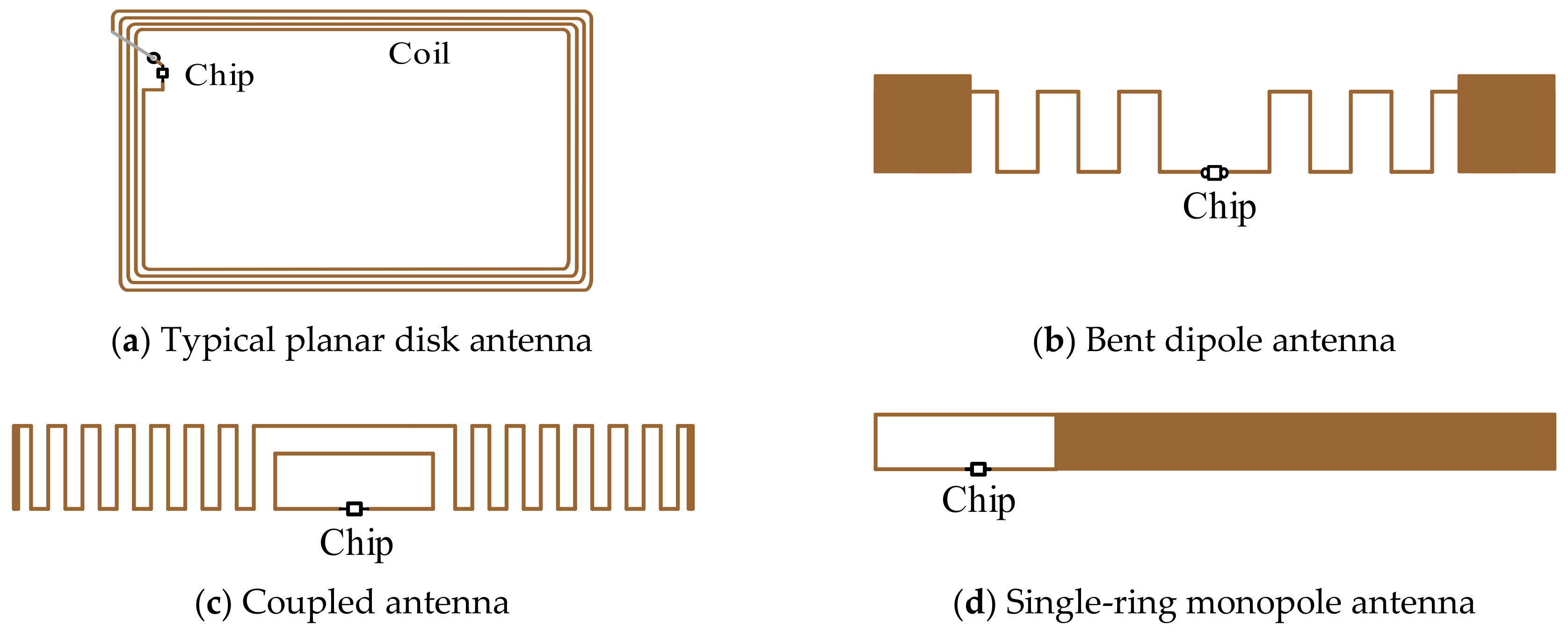
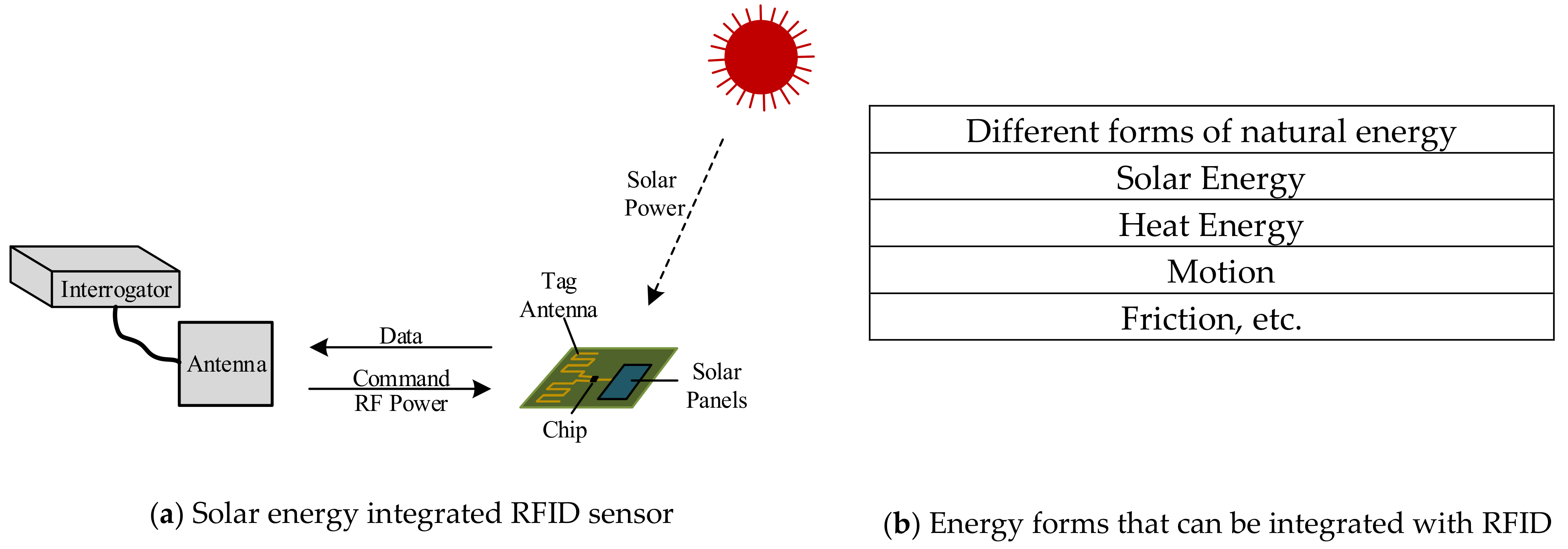
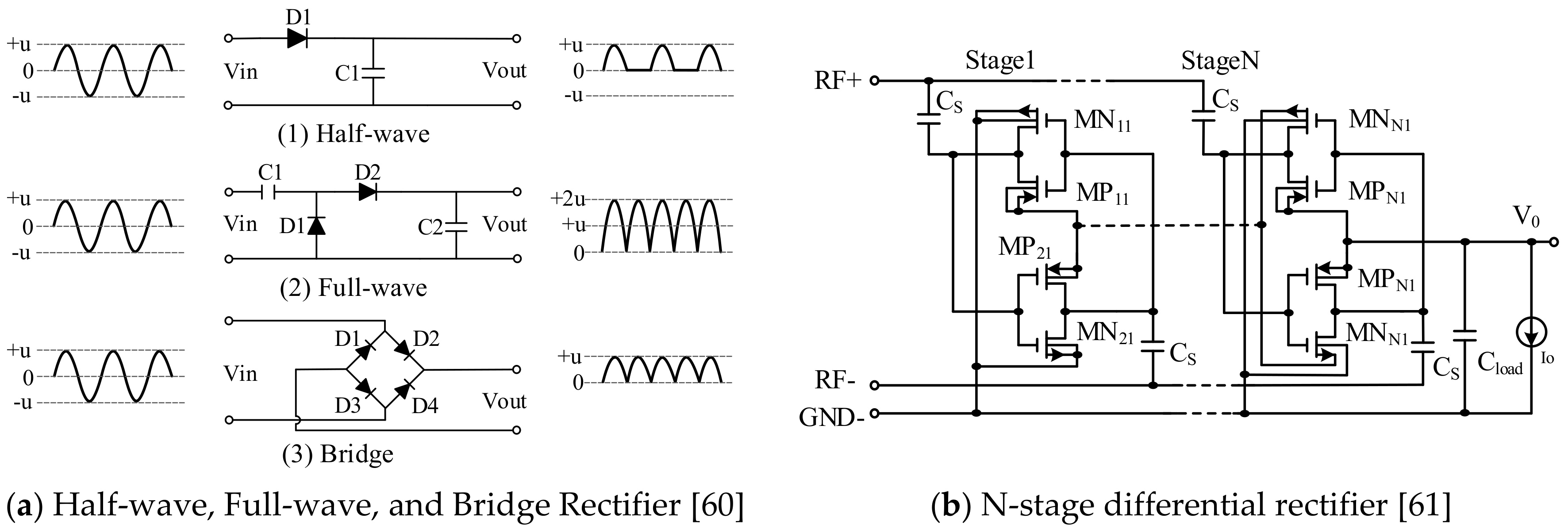

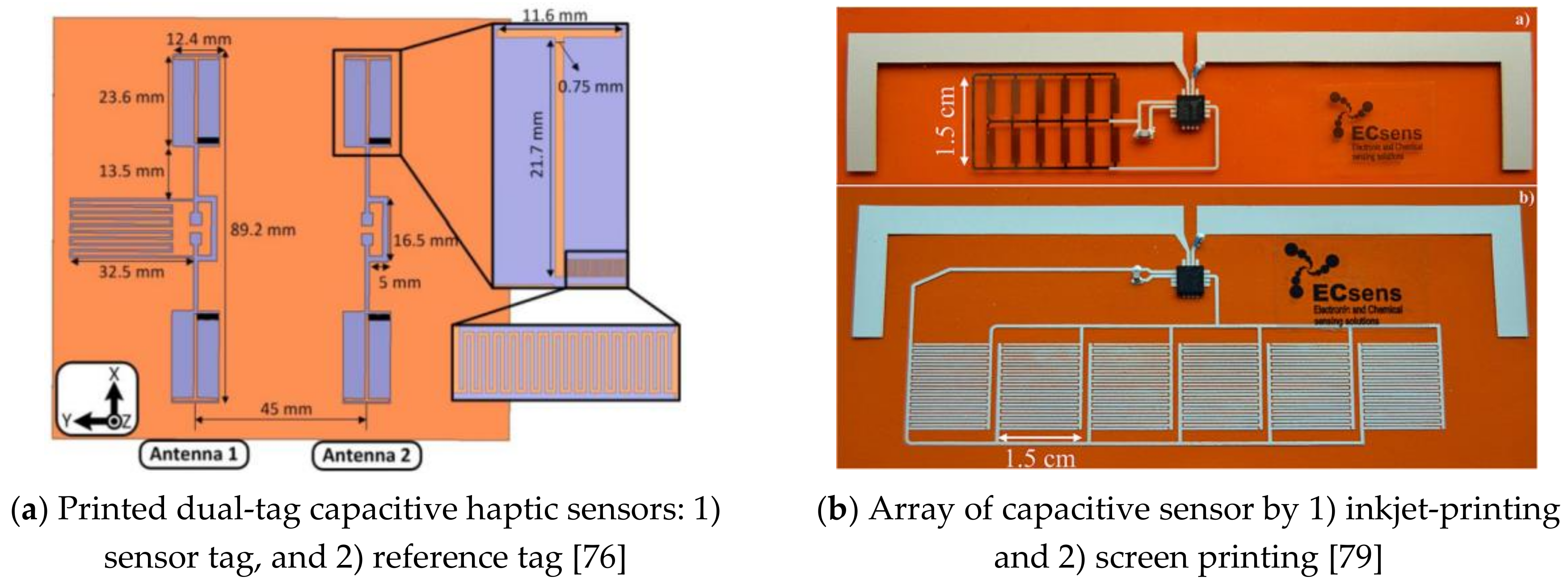
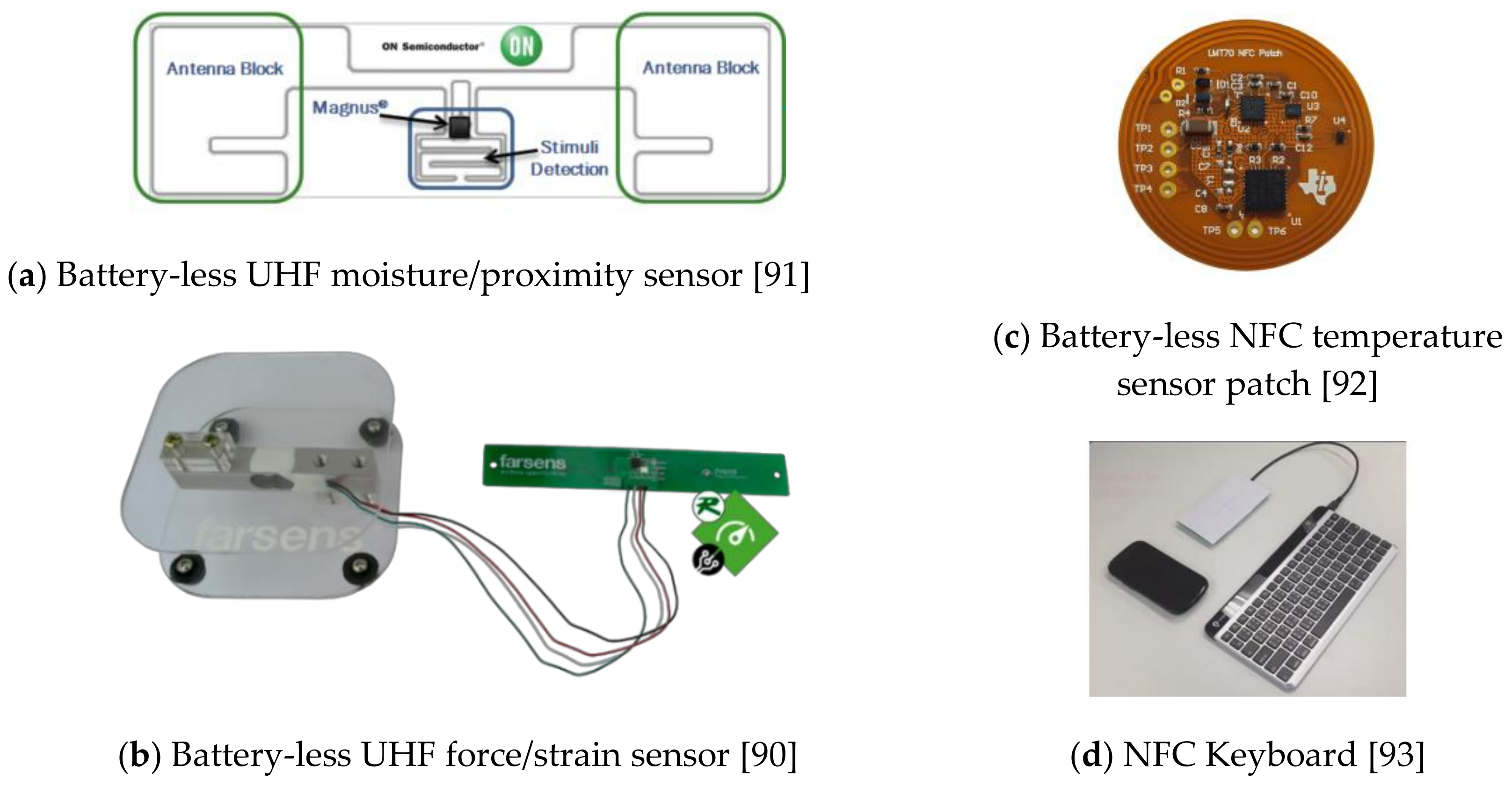

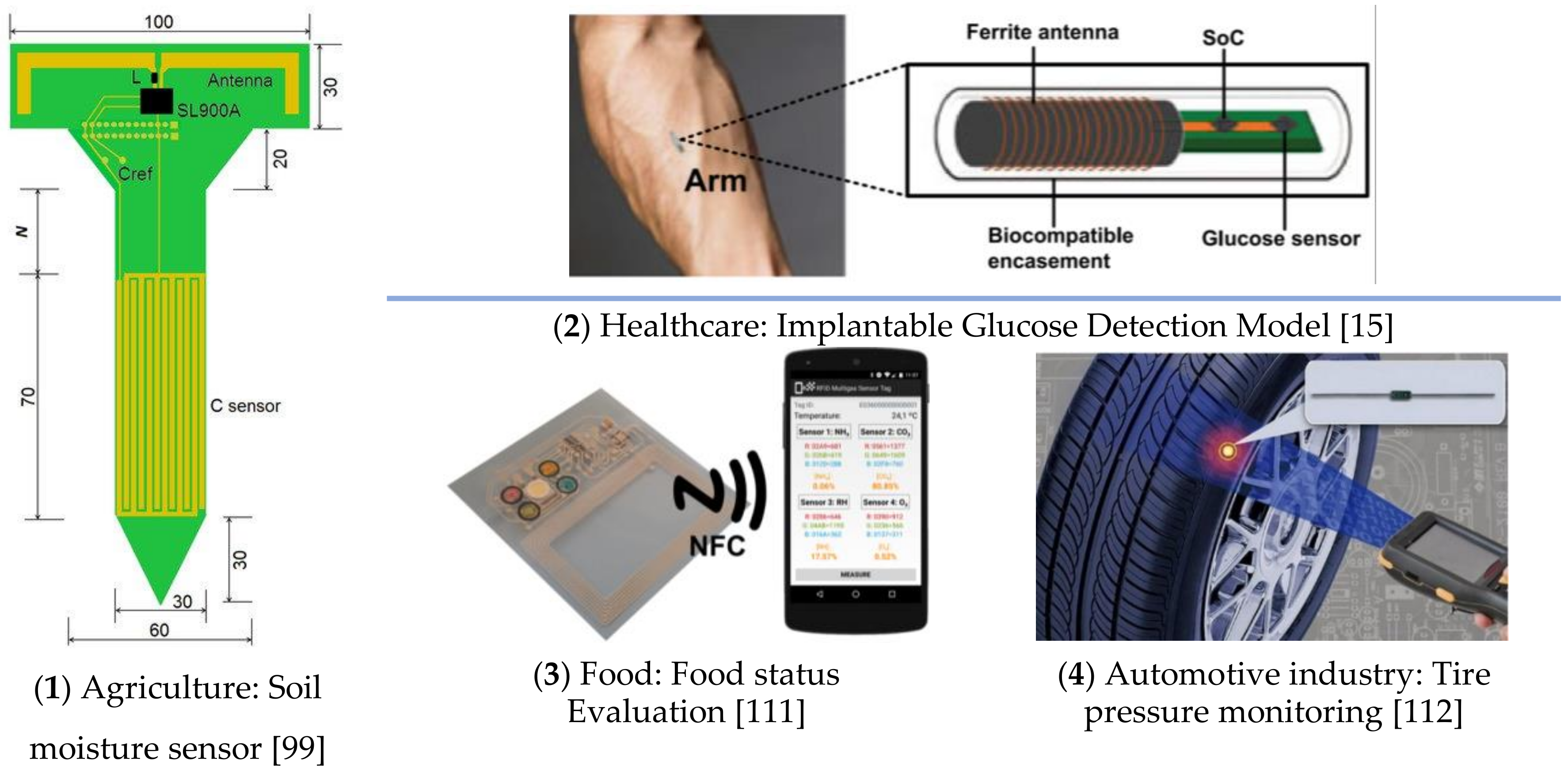
| Novel Antenna | Carrier Frequency | Size | Reading Range | Investigators |
|---|---|---|---|---|
| metallic surface mountable antennas | UHF | 30 × 18× 3.2mm3 | 1.5 m | Chen [39] |
| UHF | 106 × 44 × 5mm3 | N/A | Xu et al. [40] | |
| UHF | 104 × 31 × 7.6mm3 | 14.6m | Hamani et al. [41] | |
| UHF | 41.5 × 55 × 3 mm3 | Metal: 6.1m Dielectrics: 14.1m | Li et al. [42] | |
| 3D antennas | UHF | 3 × 3 × 3 cm3 | N/A | Kruesi et al. [43] |
| UHF | 50 × 50 × 50 mm3 | N/A | Jin et al. [44] | |
| UHF | 2 × 2 × 1.2 cm3 | N/A | Galehdar et al. [45] | |
| multi-band antennas | UHF-HF | 85 × 54 × 0.8 mm3 | N/A | Ma et al. [46] |
| UHF-MW | L: 19 cm | N/A | Keyrouz et al. [47] | |
| UHF-MW | 30 × 30 mm2 | N/A | Li et al. [48] | |
| omnidirectional and directional antennas | UHF | 866 MHz: 98.7 × 14.2 mm2 915 MHz: 88 × 14.2 mm2 953 MHz: 84 × 14.2 mm2 | N/A | Tang et al. [49] |
| UHF | 43 × 43 mm2 | 9.5 m | Liu et al. [50] | |
| UHF Near-Field | R: 80 mm | 120 mm | Zeng et al. [51] |
| Manufacturer | IC Model | RF Band/ Protocols | RF Sensitivity | Digital Interfaces | Power Output | Packaging |
|---|---|---|---|---|---|---|
| Farsens | Rocky100 | UHF/EPC Class-1 G2 | −13 dBm | SPI | 1.2 V~3.0 V | QFN-16: 4 × 4 mm |
| Ramtron | WM72016 | UHF/EPC Class-1 G2 | < −6 dBm | DSPI | N/A | UDFN-8: 3 × 3 mm |
| AMS | SL900A | UHF/EPC Class-3 | −7 dBm | SPI | N/A | QFN-16: 5 × 5 mm |
| Axzon (formerly RFMicron) | Magnus-S3 M3D IC | UHF EPC Class 1 G2 and ISO/IEC18000 | N/A | N/A | N/A | QFN |
| Impinj | Monza X-2K/X-8K | UHF/EPC Class-1 G2 | −17 dBm | I2C | N/A | XQFN-8L:1.65 × 1.65 mm |
| AMS | AS3953A | HF NFC/ISO14443A-4 | N/A | SPI | N/A | WLCSP-10: 3 × 3 mm |
| AMS | SL13A | HF NFC/ISO 15693 | N/A | SPI | N/A | QFN-16LD: 5 × 5 mm |
| TI | RF430CL330H | HF NFC/ISO14443B | N/A | SPI/I2C | N/A | TSSOP-14 VQFN-16 |
| TI | RF430FRL152H | HF NFC/ISO/IEC 15693 | N/A | SPI/I2C | N/A | VQFN-24: 4 × 4 mm |
| Melexis | MLX90129 | HF NFC/ISO/IEC 15693 | N/A | SPI | 2.8 V~3.2 V | TSSOP-20 |
| Silicon Craft | SIC4310/ 4340/4341 | ISO 14443A | N/A | UART | N/A | QFN-16: 3 × 3 mm |
| NXP | NT3H1101/1201 | ISO 14443-3 | N/A | I2C | N/A | SOT902-3: 1.6 × 1.6 × 0.6 mm |
| NXP | SL3ICS1002/1202 | UHF/EPC Class-1 G2 | N/A | / | N/A | TSSOP-8: 4.9 × 3 mm |
| ST Micro-electronics | M24LR0xE-R/ST25DV-I2C | HF NFC/ISO15693 | N/A | I2C | N/A | SO8N: 4.9 × 6 mm TSSOP8: 3 × 6.4 mmUFDFN8: 2 × 3 mm |
| On Semiconductor | N24RF64 | HF NFC/ISO15693 | N/A | I2C | N/A | SOIC-8: 6 × 5 mm TSSOP-8: 6.4 × 3 mm |
| Functions | Interface Protocols | Sensing Techniques | Fabrication Process | Size | Investigators |
|---|---|---|---|---|---|
| Humidity monitoring | Chip-less RFID | Artificial impedance surface | Inkjet Printed | 77 × 58 × 43 cm3 | Borgese et al., 2017 [78] |
| Glucose monitoring | HF NFC ISO15693 | Potentiostat | 0.13 μm CMOS | 1.2 × 2 mm | Xiao et al., 2015 [15] |
| Ambulatory monitoring | UHF RFID | Accelerometer | PCB circuit | N/A | Wickramasinghe et al., 2015 [94] |
| Implanted sensors | RFID (100 MHz) | Pressure sensor | Copper tape made | mm-sized | Moradi et al., 2017 [95] |
| E-Skin sensor | HF | Coil antennas | Flexible PCB circuit | 134.4 × 18.2 mm | Baek et al., 2018 [96] |
| Fish freshness | HF NFC | Resistive sensor and humidity sensors | Flexible PCB circuit | N/A | Smits, et al., 2012 [97] |
| Meat freshness | UHF | Temperature, humidity, gas | Assembled with modules | N/A | Eom et al., 2014 [98] |
| Soil moisture | UHF (SL900A) | Capacitive sensor | PCB circuit | 100 × 180 mm | Pichorim et al., 2018 [99] |
| Chemical sensor | UHF | Sensitive coating materials | Flexible PCB circuit | 55 × 45 mm | Manzari et al., 2014 [100] |
| Industrial process parameters | UHF RFID | Vibration, light, temperature, humidity | PCB circuit | 80 × 120 mm | Petrov, et al., 2019 [101] |
| Supply chain monitoring | HF NFC ISO15693 | Critical temperature indicator (CTI) | PCB circuit | Sensor: 35 × 10 × 2 mm Tag: not given | Lorite et al., 2017 [102] |
| Strain | UHF | Resistive strain gauge | PCB circuit | 150 × 120 mm | DiGiampaolo et al., 2017 [103] |
| Metal crack detection | Chip-less RFID | Microstrip patch antenna resonator | PCB antenna | 35 × 15 mm | Marindra et al., 2018 [104] |
| Concrete crack | UHF RFID | Couplet of RFID tags | RFID tag designed | N/A | Caizzone and DiGiampaolo, 2015 [105] |
| Corrosion in concrete | HF NFC ISO15693 | Three-electrode potentionstat | PCB circuit | 11.8 × 4 × 5.6 cm | Leon-Salas and Halmen, 2016 [106] |
| Bicycle tire pressure measurement | HF NFC ISO14443 | Capacitive sensor | 130 nm CMOS | 5.76 mm2 | Kollegger et al., 2017 [107] |
| Vehicle road distancer measurement | UHF RFID | Distance | Commercial tags | N/A | Huo et al., 2014 [108] |
| Fault diagnosis & prognosis | UHF (Monza X-8K) | Accelerometer | PCB circuit | Long: 12 mm | Wang et al., 2017 [109] |
| Metal structure displacement | UHF RFID | Deformation sensor | Custom designed | 72 × 37 mm | Kuhn et al., 2018 [110] |
© 2019 by the authors. Licensee MDPI, Basel, Switzerland. This article is an open access article distributed under the terms and conditions of the Creative Commons Attribution (CC BY) license (http://creativecommons.org/licenses/by/4.0/).
Share and Cite
Cui, L.; Zhang, Z.; Gao, N.; Meng, Z.; Li, Z. Radio Frequency Identification and Sensing Techniques and Their Applications—A Review of the State-of-the-Art. Sensors 2019, 19, 4012. https://doi.org/10.3390/s19184012
Cui L, Zhang Z, Gao N, Meng Z, Li Z. Radio Frequency Identification and Sensing Techniques and Their Applications—A Review of the State-of-the-Art. Sensors. 2019; 19(18):4012. https://doi.org/10.3390/s19184012
Chicago/Turabian StyleCui, Lei, Zonghua Zhang, Nan Gao, Zhaozong Meng, and Zhen Li. 2019. "Radio Frequency Identification and Sensing Techniques and Their Applications—A Review of the State-of-the-Art" Sensors 19, no. 18: 4012. https://doi.org/10.3390/s19184012





